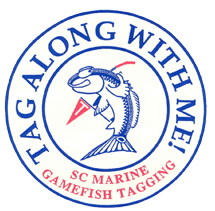Marine - Species
Spanish Mackerel (Scomberomorus maculatus)
General Description
Bluish-green on back, sides silver with numerous yellow to bronze spots and no lines or streaks, anterior portion of first dorsal fin is black, lateral line gradually curves down toward caudal fin, dorsal fins scarcely separated, first dorsal fin has 17 – 19 spines.
Average Size
15 inches, 1.5 pounds;
South Carolina State Record: 11 pounds (1983);
maximum age: approximately 11 years.
Habitat
Adults: Inhabit primarily offshore coastal waters out to continental shelf edge; sometimes over rocky bottoms and artificial reefs, or along beaches and in shallow estuaries, bays, and sounds.
Juveniles: Primarily utilize high salinity nearshore coastal and beachfront waters; some individuals may also enter estuaries.
Reproductive Cycle
- Both sexes mature by 2 years of age; approx. size at maturity: males – 8 inches; females – 11 inches.
- Spawning occurs over inner and mid-continental shelf, apparently at night. In South Carolina, spawning occurs May – September.
- Larvae remain in high salinity habitats throughout development and are most abundant over inner and middle continental shelf waters.
Foraging Habits
- Adults and juveniles are predatory, surface feeding fish, consuming small schooling fishes, including: menhaden, anchovies, herring, shad, small jacks, and pompano, also some squid and penaeid shrimp.
- Larvae and young juveniles feed on larvae of other pelagic (open-water) schooling fishes.
Availability/Vulnerability to Harvest
- Spanish mackerel form large and fast moving schools and migrate long distances. As a result, significant numbers of fish within a given area may be available to recreational harvest for only short periods of time.
- Distribution is temperature and salinity regulated. Spanish mackerel are present in South Carolina waters April – November and migrate during fall to overwintering grounds in south Florida. Fishery availability is typically highest during spring and fall migrations as schools pass close to shore. Juveniles may enter low salinity waters, but adults generally prefer higher (> 30 ppt) salinities.
- No commercial fishery exists for Spanish mackerel in South Carolina; however the potential exists for significant recreational harvest since fish may be caught close to shore.
- Conservation concerns: degradation or loss of estuarine habitat vital to the life cycle of prey species; alteration of water quality in nearshore larval habitat; potential for overfishing.
Literature Cited
ASMFC. 2006. Species profile: Spanish mackerel. In: ASMFC Fisheries Focus 15 (6). Atlantic States Marine Fisheries Commission, Washington, DC.
Berrien PL and D Finan. 1977. Biological and fisheries data on Spanish mackerel, Scomberomorus maculatus (Mitchill). U.S. Dep. Commer., NOAA Natl. Mar. Fish. Serv. Sandy Hook Lab, Tech. Ser. Rep. no. 9, 52 pp.
Collins MR, BW Stender. 1987. Larval king mackerel (Scomberomorus cavalla), Spanish mackerel (S. maculatus), and bluefish (Pomatomus saltatrix) off the southeast coast of the United States, 1973 – 1980. Bull Mar Sci 41: 822-834.
Fischer W. 1978. FAO identification sheets for fisheries purposes: western central Atlantic (fishing area 31) volume 1 – 7. Food and Agriculture Organization of the United Nations, Rome.
Godcharles MF, and MD Murphy. 1986. Species profiles: life histories and environmental requirements of coastal fishes and invertebrates (south Florida) – king mackerel and Spanish mackerel. U.S. Fish Wildl. Serv. Biol. Rep. 82(11.58). U.S. Army Corps of Engineers, TR EL-82-4. 18pp. Accessed: August, 2009.
Mercer LP, LR Phalen, JR Maiolo. 1990. Fishery management plan for Spanish mackerel. Atlantic States Marine Fisheries Commission, Washington DC. 78 pp.
Moore CJ. 1996. A field guide to the identification of marine species regulated in South Carolina coastal waters. Office of Fisheries Management, Marine Resources Division, South Carolina Wildlife and Marine Resources Department, Charleston, SC. 105 pp.
Moore CJ, M Barkley. 2005. South Carolina’s guide to saltwater fishes. South Carolina Department of Natural Resources, Special Publication. Columbia, SC 132 pp.
Powell D. 1975. Age, growth, and reproduction in Florida stocks of Spanish mackerel, Scomberomorus maculatus. Marine Research Laboratory, Florida Department of Natural Resources Pub. 5, St. Petersburg, FL. 21 pp.
Scmidt DJ, MR Collins, DM Wyanski. 1993. Age, growth, maturity, and spawning of Spanish mackerel, Scomberomorus maculatus (Mitchill), from the Atlantic coast of the southeastern United States. Fish Bull 91: 526-533.


